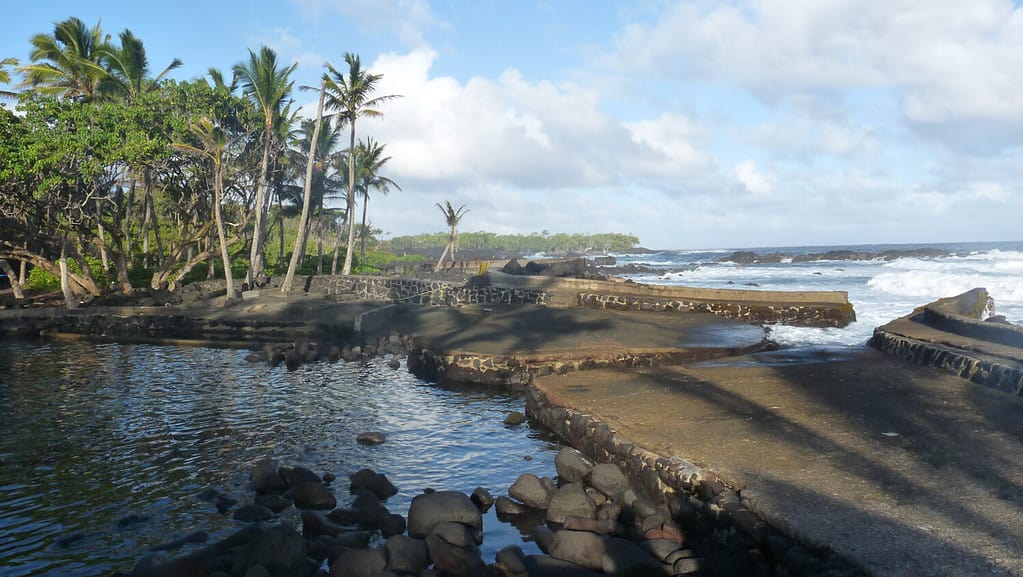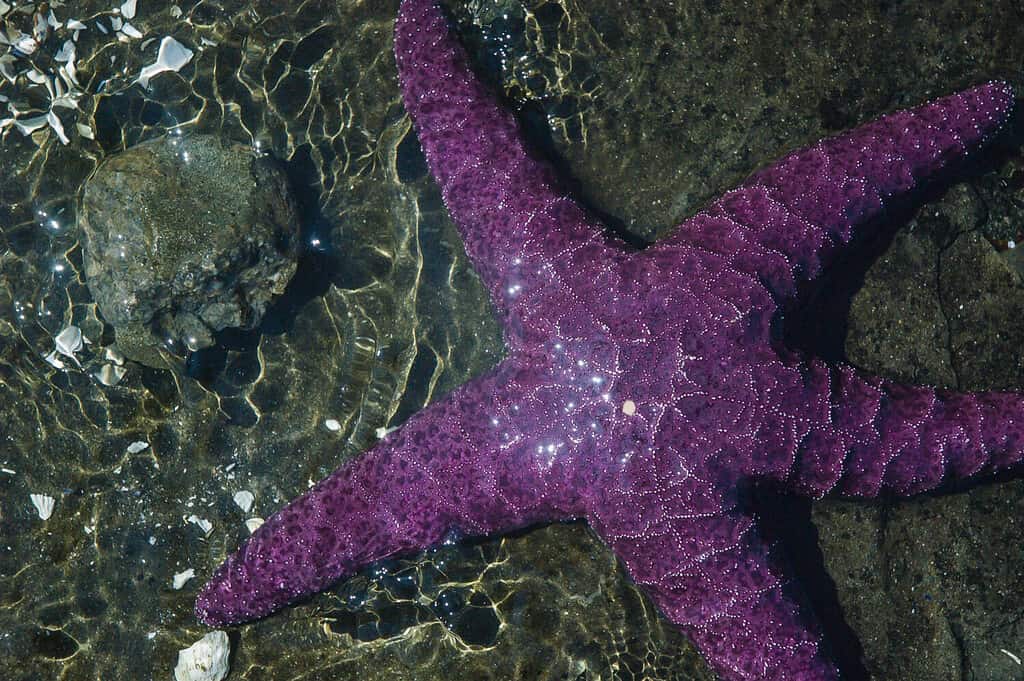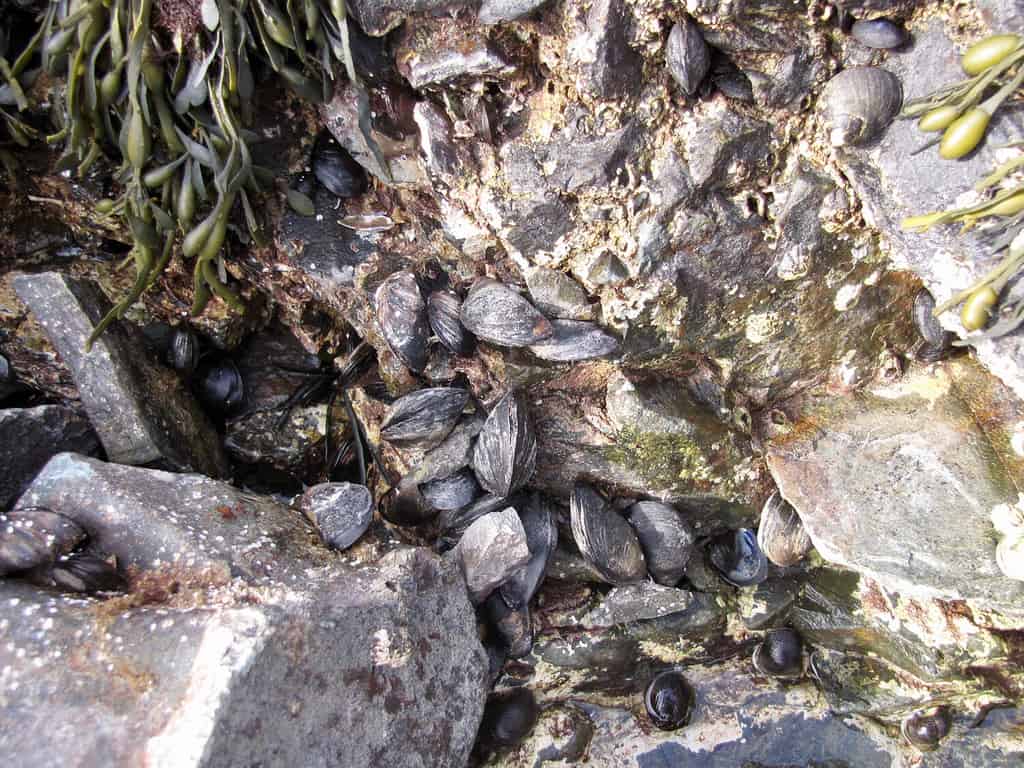
You can find limpets all over the world in an intertidal zone along rocky shores.
©Coxy58/Shutterstock.com
Have you ever watched a tide go out? You may have noticed that underneath the waves is a diverse range of marine life. In some areas, there are tidal pools, full of life that are trapped every time the tide goes away. On sandy beaches, the change may be more subtle as a few animals burrow themselves under the sand to avoid the harsh sunlight. An area like this, full of life, is known as an intertidal zone.
These zones are quite unique, and a lot harsher for the animals that choose to live in these areas than you might expect. If you want to learn more about intertidal zones and animals that may be hiding just under the water, keep reading.
What Is an Intertidal Zone?

Tide pools are safe havens for some animals that make the intertidal zone their home.
©Mam Maggy/Shutterstock.com
Intertidal zones are called extreme ecosystems because of the constant changes the zone undergoes. Because they are extreme environments, only the most durable of animals live in these habitats. Other animals may visit temporarily but are unable to make these changing zones their permanent home.
These are habitats located on the coastlines, essentially the border between the ocean and the land. Rocky shoals and beaches filled with sand both are considered intertidal zones. This ecosystem includes the area of the beach from where the highest tide touches to where the lowest tide pulls back.
In some areas, there isn’t much of a tide, and the intertidal zone is narrow. However, in some areas, such as the Bay of Fundy, there may be a length of up to 50 feet.
Intertidal zones are not only areas where tough animals live. It’s also the perfect picking for predators that live on fish, invertebrates, and shellfish. Seabirds, in particular, enjoy roaming these areas in low tides and feasting on animals within easy reach.
Changes in Intertidal Zones
Intertidal zones change all the time. As the tides shift, so do these zones. At certain parts of the day, they are submerged, while at other times of the day, they are fully exposed to the air.
Every time the tide changes, even if only by a few inches, there are drastic changes to the habitat. The power of waves, the moisture levels, the temperature, and the salinity may all be different from hour to hour in an intertidal zone.
To put it in a different perspective, imagine waking up in a moist habitat, like a rainforest. Then, as the day goes on, it gets drier and drier, until you end up in the desert. The whole time the change is occurring, harsh winds are beating against you, almost threatening to knock you over each time they blow. That’s essentially what life is like for the animals in these intertidal zones.
Types of Intertidal Zones
Intertidal zones are broken up into four different parts. This division is because of the unique characteristics and challenges each zone faces, despite all being part of the intertidal zone. Most animals that live in these ecosystems learn to live in just one of these four sub-zones. There’s not a lot of intermingling, as it’s difficult to adjust from one sub-zone to another.
Spray Zone
This sub-zone is rarely ever submerged. It is simply dampened by the spray from particularly high waves. Unusually high tides and storms are the only times this area would get submerged at all. While this sounds like a safer zone, the lack of water means animals that live here are exposed to the heat, risk drying out, and face high levels of predation.
High Intertidal Zone
The high intertidal zone faces long bouts of dryness. Only peak tides throughout the day submerge this habitat. Only the sturdiest of wildlife that has adapted to handling long stretches without water survive in this sub-zone. Predation is also common as the water is shallow enough to make most animals here easy pickings.
Middle Intertidal Zone
The middle intertidal zone floods twice a day on average. Even then, there are sometimes still low levels of water as long as the water isn’t at low tide. In quite a few middle intertidal zones, it is open-aired and submerged in equal measures throughout the day. Many animals and plants call this sub-zone their home.
Low Intertidal Zone
Low intertidal zones rarely ever dry out. The lowest tides of the year are the only exception. Because this area doesn’t experience as much of a beating as the other sub-zones, and there’s usually an easy way to move between this sub-zone and the ocean, there’s an abundance of life growing in this area. It’s probably the calmest of all the sub-zones, which is why it can hold more life than the other three.
Animals Found in Intertidal Zones

Sea stars can make themselves comfortable in rather shallow tide pools during low tide.
©Kaitlin Kelly/Shutterstock.com
Because of the way intertidal zones are constantly changing, the animals that live in them have to be able to handle different water levels, salinity, temperature, and wave strength.
All sorts of animals make themselves at home in intertidal zones. You will find mammals, especially those that transition easily between land and sea. Invertebrates, fish, worms, shellfish, urchins, and many more types of animals have adapted to these zones.
Some examples of animals you’ll find in the area between the ocean and the beach are:
- Sea Lions
- Seals
- Barnacles
- Mussels
- Hermit Crabs
- Crabs
- Snails
- Sea Stars
- Fish
- Seagulls
- Shrimp
- Worms
- Clams
- Sand Dollars
- Limpets
How Animals Handle Harsh Intertidal Zones

Clams will dig under the sand when the tide gets low.
©Jeff, CC BY 2.0 <https://creativecommons.org/licenses/by/2.0>, via Wikimedia Commons – License
Intertidal zones are pretty extreme environments. The habitat is constantly changing. Unless an animal can adapt to that change, there’s no way they are going to survive. Many animals make intertidal zones their homes and have created ways to survive the constant changes.
Move Away
Some animals don’t face much of a problem in intertidal zones. Seal lions and seals come and go from these areas at will. When the tides get too low, or the waves are too strong, they simply move further on land or into water. Not all animals are that lucky, however.
Close Up and Anchor

Certain species such as mussels and barnacles will anchor themselves to rocks in response to the push and pull of waves.
©JonPeckham/Shutterstock.com
Mussels and barnacles have made unique adaptations. They need water to survive, or they dry out. To combat this, they will close their shells during low tides. This keeps them from drying out until the tides come back in. They are also experts at anchoring themselves to rocks. This allows them to fight against the push and pull of waves.
Hide in Tidal Pools
Other animals know that there are small pockets of water where they can survive when the tide goes out. Animals like fish, sea stars, and shrimp can’t handle low tides or shallow bodies of water. They need water to breathe and survive, but they still live in intertidal zones.
They survive by taking refuge in small tide pools. These are cracks and crevices that have been worn down by weather over time. When the tide goes out, the ocean water remains in these pools. The deeper ones make perfect areas for fish and other animals to rest and wait for the tide to return.
Bury Themselves Under Sand
Other animals still survive best by burrowing in the sand. When the tide gets too low, some animals like clams and sand dollars will bury themselves in the sand. This helps to keep them moist and cool where they would otherwise dry out and overheat quickly.
The photo featured at the top of this post is © Adam Springer/Shutterstock.com
Thank you for reading! Have some feedback for us? Contact the AZ Animals editorial team.







